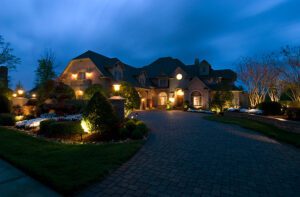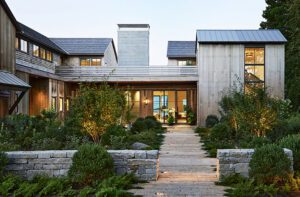A Modernist Cape Cod Stunner
May 30, 2019
Text by Nathaniel Reade Photography by Jim Westphalen Produced by Karin Lidbeck Brent
When people think of historic Cape Cod architecture, they usually picture a “Cape,” that steep-roofed, cedar-shingled box with small windows and no frills. How then, can the architects behind a very modern house in Truro with a flat roof, horizontal lines, and walls of glass claim that it was inspired by the Cape’s architectural history? Because, it turns out, the outer Cape was also one of the nation’s major centers of modernist design.
Before World War II, some of Europe’s greatest architects and designers, such as Bauhaus veterans Walter Gropius and Marcel Breuer, settled in and around Boston. Back then, the outer Cape—Provincetown, Truro, Wellfleet—was hard to get to and economically depressed, so land was cheap. And the rolling dunes, scrub pines, and kettle-hole ponds as clear-blue as the Caribbean had long since attracted a community of forward-thinking writers and artists, from Eugene O’Neill to Robert Motherwell. So, Breuer and Gropius, along with other icons of the modernist movement like Eero Saarinen, Olav Hammarstrom, and Serge Chermayeff, designed and built relatively inexpensive houses on the outer Cape for themselves and their clients, turning it into one of the country’s great modernist hotspots.
Architects Don DiRocco and Mark Hammer, of Hammer Architects, were inspired by that history when they designed this modernist Truro home for physician Katherine O’Flynn Christian and filmmaker Alan Metter. When Metter and Christian met over a decade ago, she talked about a cabin in the woods for a second home, maybe in Tennessee. He is a native of Sharon, Massachusetts, however, who had been going to Truro most of his life. When he brought Christian to the Cape, she loved it so much she suggested they stop by a real estate office. They searched for a few years, always intending to renovate an existing home. The house they eventually bought was, says Metter, “a small midcentury-modern box. No insulation, but the view was spectacular, across a marsh and all the way to Corn Hill.”
As they started to work on renovations, however, the couple realized the house was beyond repair. The foundation was cracked, the basement wet, the roof leaked, and the design dark and overbearing. They had no choice but to tear it down.
Metter had long loved modernism, and Christian had become a fan as well, so when they started to plan the new house with DiRocco and Hammer, modernist style seemed like the obvious choice. Metter cites the history of modernism in that part of the Cape, but also the practicality of it. A philosophy major in college, he was drawn to the Pragmatists, and he believes in a central tenet of the Bauhaus designers, that “form follows function.” He practiced that while making movies with Rodney Dangerfield, Sarah Jessica Parker, and a young Ben Stiller. “My shot selection was always to make the camera invisible and get the story told,” he says. He and Christian applied this same ethos to their new house.
“The view is the reason for the house being there,” Metter says, “so we wanted a lot of glass.” Visitors don’t see the view until they reach the front door. Immediately inside, they are wowed.
The open living room, dining room, and kitchen, as well as the master bedroom and bath, take up the first floor and face the water. Because the lot is quite steep, hemmed in by setbacks on both sides and zoning height restrictions, that main floor couldn’t have been any bigger without the use of very tall supports. So the architects skillfully fitted in a walk-out basement and second floor, which, with the flat-roof motif, seem to snap together onto the main space like Legos.
DiRocco and Hammer used carefully placed steel posts to create strong, wind-shear-resistant glass walls, and a quiet look that draws attention not to the architecture, but to the views. Sliding glass doors connect inner and outer spaces. Overhangs shade the hottest hours of the sun, and awning windows placed low on one wall and high on another provide a constant flow of air to keep things cool.
“I’d never built a house before,” Metter says, “but there are many parallels between building a house and making a movie. You have to imagine the scene, then put the parts together to make it real.” And a movie set has departments, from lighting to makeup, “so you hire good people and you trust them. Houses are the same way.”
Besides DiRocco and Hammer, Metter appreciates the work of builder Eric Winslow, who brought the meticulous skills of an old-world craftsman. Winslow’s father, also a builder on the Cape, constructed midcentury-modern houses designed by famous modernist architects for Woman’s Day magazine, which furnished the materials and then sold the plans.
Christian is an avid gardener who gave input to Cambridge-based landscape architect Jessalyn Jarest, but also trusted her to handle the complex problems of incorporating parking and screening neighbors on the top of a steep hill. Jarest explains that the midcentury architects tried to preserve natural vegetation as much as possible, so that their houses felt surrounded by nature. She used native trees and shrubs like red pines and tupelo to hide the neighbors, and bayberry and sweet fern to create a sense that the house is grounded in the local habitat. Then, together with Christian, she chose colorful perennials for the entrance. “We had native vegetation come up to the house,” Jarest says, connecting it to the natural landscape, “but then added pops of vibrant colors around the doorway so you really feel that you’re arriving.”
Metter and Christian collected midcentury modern art and furniture for this house until their garage in Florida was so full they had to park their cars outside. They bought modernist paintings in New York galleries and found the Pierre Paulin Ribbon chair and whale’s tail ottoman on eBay and had them reupholstered.
Christian did much of the interior design, choosing surface details from tile to doorknobs.
“She really led the project,” Metter says. “I’d throw her ideas, but it’s her house, and she never let me down. She kept my good ideas and got rid of the bad ones. ‘Your work on this is so good,’ I told her, ‘that this is going to be a magazine house.’ ”
And he was right.
Project Team
Architecture: Don DiRocco and Mark Hammer, Hammer Architects
Builder: Eric Winslow, Eric E. Winslow Builder
Landscape design: Jessalyn L. Jarest, Jessalyn Jarest Landscape Architecture
Share
![NEH-Logo_Black[1] NEH-Logo_Black[1]](https://b2915716.smushcdn.com/2915716/wp-content/uploads/2022/08/NEH-Logo_Black1-300x162.jpg?lossy=1&strip=1&webp=1)


















You must be logged in to post a comment.